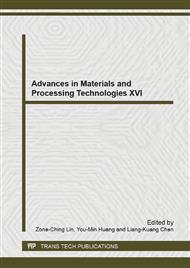p.313
p.322
p.328
p.336
p.342
p.349
p.355
p.361
p.367
Influences of Process Conditions on Stretching Characteristics of Crystalline Polymer Film
Abstract:
Developing the interior structures of polymer films is essential for creating novel functions of such films. This study investigates the effects of extension parameters and processing procedures on the super-structure of a polypropylene (PP) film. An biaxial extension device is also designed and fabricated to analyze the effects of annealing, extension temperature, extension rate and other parameters on the super-structures of PP films. Based on super-structure analyses, the relationships between extension parameters and film structures are determined, and an extension process that involves a second time stretching procedure is suggested. Experimental results indicate that void structures can be generated by biaxial extension at the interface between the crystalline and amorphous regions in a film. The mechanical strength of the film is also affected by stretching and become highly oriented. Although a low extension temperature can increase the number of void structures generated at a low extension ratio, structure sizes are dispersed. Additionally, voids with uniform size can be obtained when the film is stretched at a high temperature; however, it needs a high extension ratio to promote the formation of void structures. As for annealing treatment, when the annealing temperature increased, the size and quantity of the spherulites that were formed in films by annealing also increased, but these films tend to have similar sizes and numbers of void structures. Based on the experimental results, this study also describes how parameters influence the void structures of a PP film created during the extension process. Analysis results further demonstrate how extension parameters and processing procedures can be adjusted to improve the fabrication of PP films.
Info:
Periodical:
Pages:
342-348
Citation:
Online since:
May 2014
Authors:
Price:
Сopyright:
© 2014 Trans Tech Publications Ltd. All Rights Reserved
Share:
Citation:


